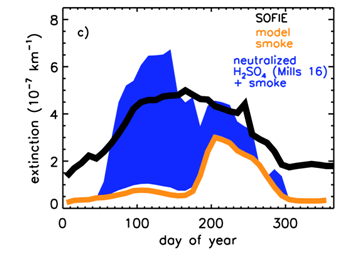|
STATUS:
01.26.2017
Instrument Status:
The AIM spacecraft continues to perform well.
SOFIE:
The SOFIE instrument continues to operate normally. As the orbit changes, SOFIE is now viewing tropical through polar latitudes. SOFIE is providing high precision measurements over relatively fast latitude sweeps, which will be used to explore a variety of parameters including meteoric smoke, gravity waves, and nitric oxide. SOFIE V1.3 data have been released through August 2016. More recent data are being processed and should be released on the SOFIE web page within days.
Investigations of SOFIE meteoric smoke measurements recently lead to the discovery of a seasonal layer of neutralized H2SO4 aerosol mixed with meteoric smoke. This autumnal layer is located above the nominal stratospheric sulfate (H2SO4) aerosol layer and into the lower mesosphere [Hervig et al., 2017]. Meteoric smoke has traditionally been understood as a passive tracer which follows the global mesospheric circulation. Smoke extinctions from SOFIE, however, show that while this is true in the middle to upper mesosphere (pressure < ~0.2 hPa), it is not true near the stratopause. Here, the observed winter increase begins three months earlier than in models. Comparison of SOFIE with models suggests that the autumn extinction increase is due to H2SO4 condensing above the nominal stratospheric aerosol layer (~5 hPa). This is possible due to lowering of the H2SO4 saturation vapor pressure when the acid is neutralized through combination with meteoric metals. The appearance of neutralized H2SO4 in autumn is associated with the seasonal decrease in temperatures. The combination of meteoric smoke and neutralized H2SO4 aerosols explains the observations, as seen in the Figure below.

The Figure shows annual time series as 10-day averages for 2008 – 2012 at 1.8 hPa pressure (~40 km) near 70°S latitude. SOFIE aerosol extinctions are compared to modeled meteoric smoke, and to neutralized H2SO4. The neutralized H2SO4 extinctions were added to the smoke extinctions, and the range in values is due to the model optical uncertainties. These results support previous suggestions that H2SO4 could condense above the nominal stratospheric sulfate layer.
Hervig, M. E., C. G. Bardeen, D. E. Siskind, M. J. Mills, R. Stockwell, (2017), Meteoric smoke and H2SO4 aerosols in the upper stratosphere and mesosphere, Geophys. Res. Letters, 44, doi: 10.1002/2016GL072049.
|
